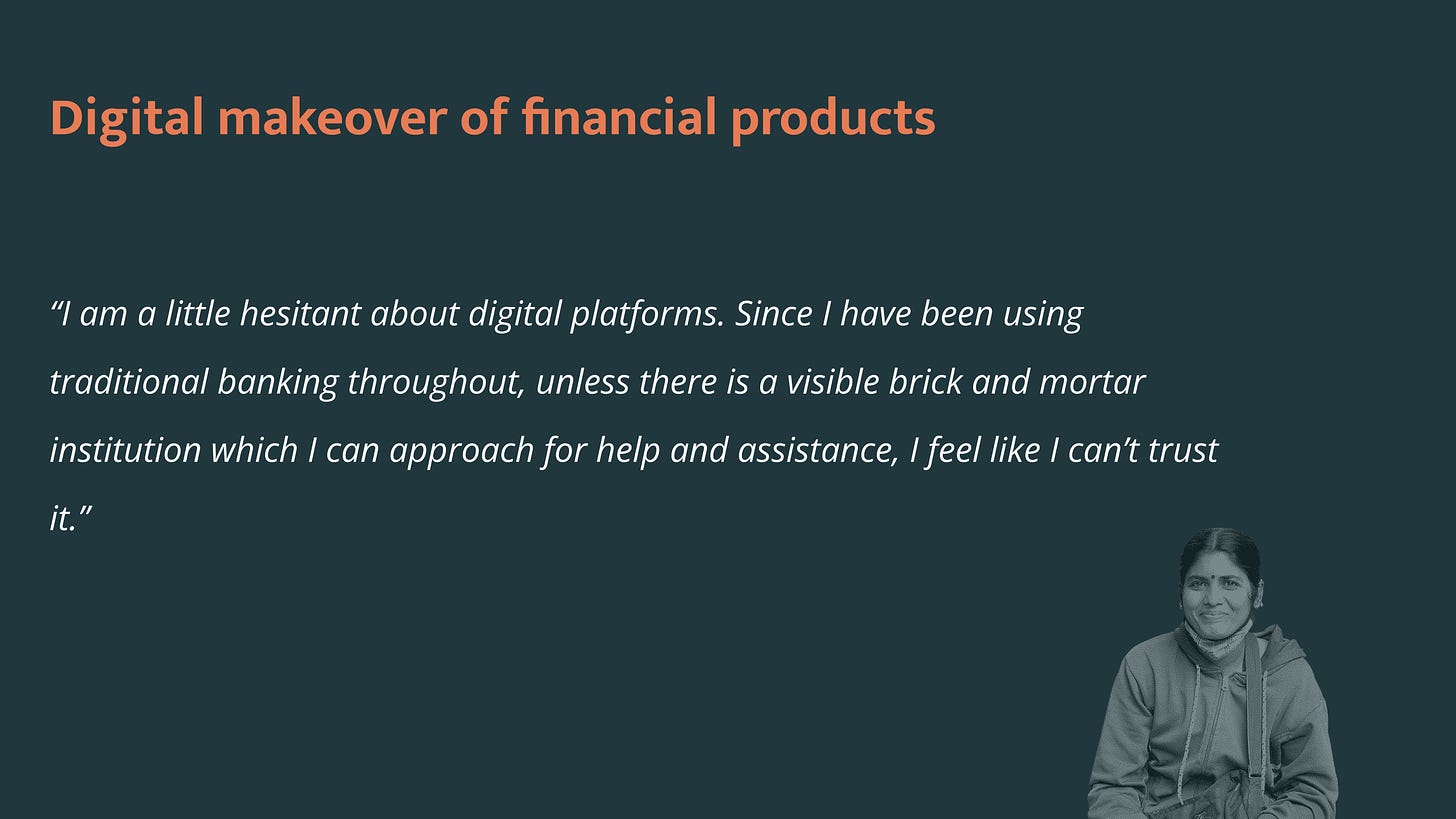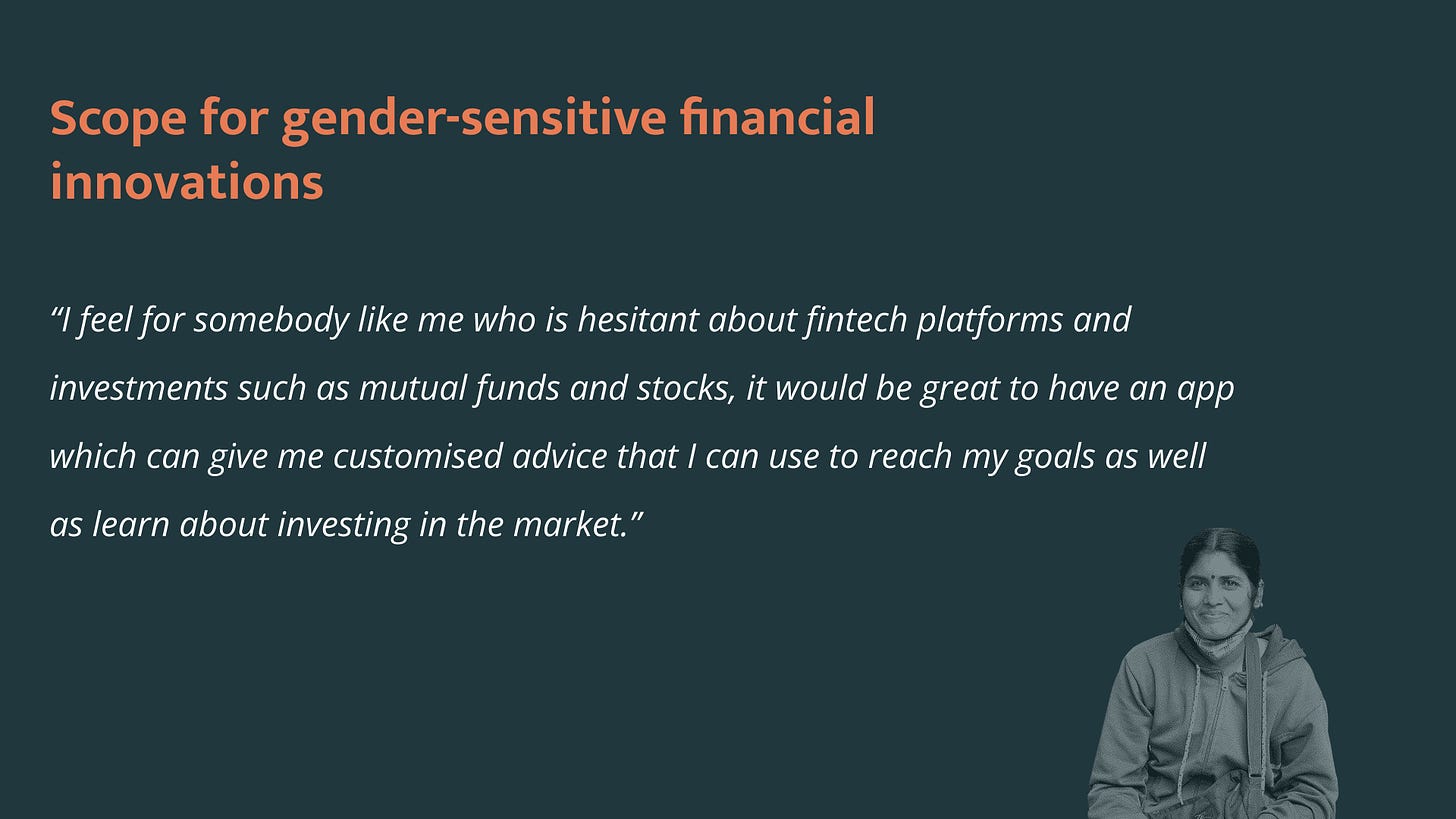Women are buyers, they cannot be sold to!
We hosted a webinar on women’s financial inclusion by bringing together the experience of 6 women working at the intersection of finance, tech & research for women. Here’s our final learnings!
In the first blog, we discussed how women are cautious and very keen to take perfect action, which sometimes leads to inaction. We also observed how various life circumstances contribute to this desire for a perfect action. We built on this understanding by looking at the usage barriers for financial products and services among Indian women under blog 2.
We also touched upon the nature of businesses that are run by most women in India and why their needs for financial products and services do not always get fulfilled. In doing so, we arrived at the role of technology and digitization in making this possible.
With the ever-increasing smartphone penetration and the new internet-based way of life, fintech in India is largely the future of finance.
To determine what fintech would mean for women users, we asked our panelists their view on the role that technology and digital financial products play in achieving financial inclusion for women.
We received a few interesting perspectives on women’s consumer behaviour, the difference between building for the salaried class and women with irregular and uncertain income, and finally the role that trust plays in nudging women to use any product or service.
#1 The consumer behaviour conundrum
Consumer behaviour of men and women is inherently different, explained Chaitra from her experience in the field while building Simpl (her first start-up venture).
Men have a confident and somewhat rigid yes or no response to most things you ask them, including financial products. They are not likely to change their view. Women on the other hand are fence-sitters. There are a number of socio-cultural reasons for that. Most women juggle a lot of things in their life and so there is very little time for trial and error. They want to make value-conscious and thoughtful decisions, driven by the perceived value of the product to them, and so women tend to choose slowly and more deliberately. Therefore, they tend to fence-sit till they reach this decision in most cases.
Products that were traditionally marketed to women such as cosmetics, fashion apparel etc. have understood this consumer behaviour early on and built their marketing strategies keeping this at the forefront of their design.
If there is anything that could possibly accelerate this decision-making among women, Chaitra added, it is social proof of the value of any product among the circles that a woman consumer frequents.
This is based on the implicit trust that exists among women from a common social circle.
So it appears that women are fence-sitters and require trust at the foundation of their interactions be it with a product, a company, or a person!
In the market, existing financial products have been built to sell to women, but women cannot be sold to through incessant persuasion and marketing, they are inherently buyers!
#2 Value generation in product design - what it means.
Sairee overlayed some historical and macro understanding to this unique consumer behaviour.
Traditionally, financial institutions such as banks, built products for the salaried cohort. The EMI model, the fixed payment amounts etc. were all features that worked for the salaried employee. When fintechs became all the rage, they also started to build for pretty much the same cohort but just possibly better and more efficient. The features remained as is.
Let’s take an example of customer support features.
Traditional financial institutions have inaccessible customer support. This is true and widely accepted be it in person or over telephone, the internet or the app. Fintechs in an attempt to make this more “efficient” have built-in the customer support within their platforms through chatbots etc.
But does this approach work for women consumers?
As Sairee pointed out, even today, the salaried class among women consumers in India is very limited. So there are effectively no products being built for the non-salaried woman, who form the largest part of the women consumer cohort.
The key features of the design for a gender-intelligent product valuable to most woman consumers are trust generation accompanied by flexibility and simplicity of process (as we discussed in our earlier blogs as well).
Customer support features both the traditional ones as well as the more “efficient” fintech ones have not worked for women because they fail at generating value for them! This continues to be true for a wide variety of other design features of financial products and services including products in the fintech basket.
It is a myth that women do not want to adopt the fanciness of fintech in their financial products. Otherwise platforms which are digital first but were built keeping the woman front and centre, would not be performing so well!
And the truth is there is a huge untapped market here! As Sairee astutely pointed out, gender-intelligent financial products available in the market today can possibly reach maybe 10 million-plus women, at scale. But there are 400 million women in India, of which about 200 million women are ready to be served. Accounting for the heterogeneity of this cohort, this is still a very large segment that no one is building for!
The pandemic saw a surge in product building and is arguably been a great time for fintech in India. Sanjana chipped in with her experience on digital acceleration during the pandemic.
The pandemic pushed more and more people to go digital very quickly, distribution channels improved and more people saw the value in serving a digital audience with the best services. Women across all geographies rallied together within communities to quickly figure their way around technology and its everyday necessity. However, in the post-pandemic world, the proxies that had come in from the supply side to help people deal with technology better have not sustained and as such only those that have organically evolved within communities have remained.
Through the discussion, we established what works for women and that there is a market to cater to. To wrap up the discussion we spoke to a user to find out we as researchers, developers and practitioners got at least some of this right.
We asked Markordor Myrthong, a paper cutting artist and an entrepreneur from Shillong, about her experiences with financial products and services.
While explaining her personal and financial journey, Markordor highlighted some of the themes we have previously discussed in this series and through the webinar - her life circumstances and her desire to balance her personal and professional life which led her to quit her corporate job and start a business that was more integrated to her life. How she learned a new skill as a business opportunity with the support of her husband and juggled her papercutting business with helping her family in their shop while maintaining her personal and familial life. How she used Instagram to promote her business and also to improve her skills as an artist!
On the financial front, she threw light on her lack of personal assets, struggles as she navigated intimidating financial institutions, blind need for guarantors, and documentation. Finally, her reliance on digital fintech platforms worked for her to avail timely and sufficient credit. Relying on a trusted community through SHEROES and on Mahila Money, which offers products for women like her, she has managed to achieve financial freedom to support herself (without involving her family) and has also built her business from scratch.
To understand her story was to acknowledge that her impressive growth mindset was met with a financial product that was designed to specifically address her prerequisites. These include flexibility, self-reliance, simplicity of process, and most importantly trust. This is what made formal finance work for her!
Are you innovating to improve women’s financial inclusion? Tell us more about it below and get a chance to feature on the D91 Labs Idea Series!
All artwork has been designed by Prajna Nayak.
If you enjoyed reading this blog and would like to receive more such articles from D91 Labs, please subscribe to our newsletter here.
You can follow us on Twitter | LinkedIn | Instagram | YouTube






